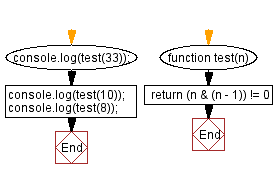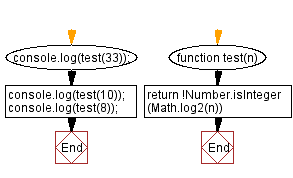JavaScript: Check sum of consecutive positive integers
JavaScript Math: Exercise-73 with Solution
Express as Sum of Consecutive Integers
Write a JavaScript program to check if a given positive integer can be expressed as the sum of two or more consecutive positive integers.
Sample Data:
33 can be represented as 11 + 22
10 = 1+2+3+4
but 8 cannot be represented in this way.
Sample Solution-1:
JavaScript Code:
/**
* Checks if a given number is not a power of two.
* @param {number} n - The number to check.
* @returns {boolean} - True if the number is not a power of two, false otherwise.
*/
function test(n)
{
// Perform bitwise AND operation between n and n - 1, and check if the result is not zero
return (n & (n - 1)) != 0;
}
// Test the function with different numbers
console.log(test(33)); // Output: true
console.log(test(10)); // Output: true
console.log(test(8)); // Output: false
Output:
true true false
Flowchart:

Live Demo:
See the Pen javascript-math-exercise-73-1 by w3resource (@w3resource) on CodePen.
Sample Solution-2:
JavaScript Code:
/**
* Checks if a given number is not a power of two.
* @param {number} n - The number to check.
* @returns {boolean} - True if the number is not a power of two, false otherwise.
*/
function test(n){
// Calculate the base-2 logarithm of n and check if it's not an integer
return !Number.isInteger(Math.log2(n));
}
// Test the function with different numbers
console.log(test(33)); // Output: true
console.log(test(10)); // Output: true
console.log(test(8)); // Output: false
Output:
true true false
Flowchart:

Live Demo:
See the Pen javascript-math-exercise-73-2 by w3resource (@w3resource) on CodePen.
For more Practice: Solve these Related Problems:
- Write a JavaScript function that checks if a positive integer can be expressed as the sum of two or more consecutive positive integers.
- Write a JavaScript function that finds one possible sequence of consecutive integers whose sum equals a given number.
- Write a JavaScript function that returns all possible sequences of consecutive numbers that sum to the given integer.
- Write a JavaScript function that validates input and handles cases where no consecutive sequence exists for the given number.
Go to:
PREV : Check Pronic Number.
NEXT : Hexadecimal to Binary Conversion.
Improve this sample solution and post your code through Disqus.
What is the difficulty level of this exercise?
Test your Programming skills with w3resource's quiz.
